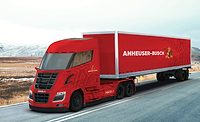Distribution
The present and future of AI in beverage delivery
Investments by truck manufacturers teases autonomous’ potential

Image courtesy of Getty Images
If 2023 is remembered for anything, it’ll be as the year that AI went mainstream. No, our robot overlords haven’t taken over, it’s just that conversations about artificial intelligence dominated virtually every industry — from entertainment to consumer packaged goods.
Although some of the more obvious types of AI — namely, self-driving vehicles — are still years away from widespread deployment, there are many facets of AI that most fleets are probably already using without even realizing it.
“Self-driving trucks — is that going to happen? There are lots of different opinions about that,” says Tom Moore, founder of the supply chain-focused company ProvisionAI. “And that’s exclusively run by AI. In the short-term, we’ve already got AI running — I’ve got it in my pickup.”
Safety-related technologies like lane departure alerts and dynamic braking are all powered by AI.
“The AI is sensing things and making a whole bunch of calculations — ‘is this a risk?’” he explains. “Already, AI in vehicles is taking camera data and making analyses. ‘Have I crossed the white line or am I about to cross the white line? Am I crossing the car in front of me?’”
Much of the current research in the AI beverage delivery space is focusing on the future of load optimization.
“We’ve found that on average we can pick up about 5% [savings] by being smart about how you put things on the truck,” Moore notes, referencing a study ProvisionAI conducted for a beverage company.
He points out that, for instance, there’s a subtle weight difference between a 12-ounce can of Coke and the same-size can of Diet Coke. Such a discrepancy, though negligible in human perception, can help high-volume fleets realize time and cost savings.
“You can leverage that to get an extra pallet on the truck,” Moore explains. “If I can get one more pallet on the truck, that’s huge. … Not only do you ship on fewer trucks, the [environment, social and governance] (ESG) benefits are huge because you’re eliminating all of that carbon and cost. It’s a super-big win.”
Another key area that could potentially benefit from an AI interface is picking the load before it’s on the truck. The move from side loaders to rear-load vehicles has enabled greater load efficiency, but, picking those loads, Moore suggests, is still far from perfect.
“There’s been very little tech put in place to help the picking process be optimized,” Moore argues. “[The existing tech] says ‘pick here, go here,’ but that’s not necessarily the best approach. You need to be able to pick in such a way that you’re building a pallet that’s not going to fall over. You’ve got different sizes and shapes of bottles and cans and you’ve got to put it all together in one place.”
He points to SKU proliferation, especially in the past 20 years, particularly in the beer space.
“The beer distributors, originally they sold Miller, but today, they sell Miller and 250 other brands, all of which have three or four flavors,” he says. “How do we make these transitions from side loaders to rear loaders, then to rear loaders that actually have good pallets built in them in an efficient way?”
There also could be an AI solution for inbound deliveries. A supplier truck could be scheduled to arrive and on that truck could be any number of SKUs — from a single SKU to dozens.
“The complexity of the job means it’s really difficult to understand what to do,” Moore says. “To know which inbound to unload first, what’s going to be needed first so I make the right connections — from a human perspective, you can do it, it just takes a lot of time to look at all of the things going on, the sheer breadth of information they’re dealing with.”
Looking for a reprint of this article?
From high-res PDFs to custom plaques, order your copy today!





